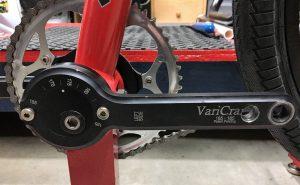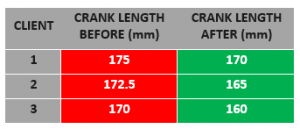 BACKGROUND – CRANKARM LENGTH
BACKGROUND – CRANKARM LENGTH
Over the past 18 months, I have collected crank arm length data from my bike fit clients. During the bike fit interview process, most of my clients v olunteer that they have had prior bike fits, but they are still in pain. Many have had refits and even been to Chiropractors, but they are still experiencing knee pain. Most of the issues I have resolved focus on the following (a) wrong cleat placement, (b) wrong saddle position and (c) wrong crankarm length.
olunteer that they have had prior bike fits, but they are still in pain. Many have had refits and even been to Chiropractors, but they are still experiencing knee pain. Most of the issues I have resolved focus on the following (a) wrong cleat placement, (b) wrong saddle position and (c) wrong crankarm length.
Both (a) and (b) above can be fixed by an experienced bike fitter, (c) can be fixed by bicycle and component manufacturers placing shorter cranksets [crankarms] on most bicycles.
But first, a background story. Two and a half years ago, 3 best friends, all in their 70’s, started cycling. They have known each other for decades and did everything together. After retiring, they started cycling. First were the shiny new bikes followed by what they thought was a good bike fit.
After riding for several months, they all developed severe knee pain. They initially attributed this pain to not having ridden before, but, when their pain got worse, they went back to their local shops for another bike bit.
Fast forward another month and the pain in their knees got even worse. They were thinking of giving up on cycling when they decided to try one more bike fitting. Several of the San Diego teams that I do bike fitting for referred the three gentlemen to me.
There were two major problems I needed to immediately address. (a) their cleat placement was way off and (b) each of their crank arms were way too long for them. After fixing their cleats, I placed each of them on my Serotta Size Cycle. Using the 140mm to 185mm Vari-cranks, the resulting change is shown in the table to the right.
their crank arms were way too long for them. After fixing their cleats, I placed each of them on my Serotta Size Cycle. Using the 140mm to 185mm Vari-cranks, the resulting change is shown in the table to the right.
Thirty days later I contacted them and they all said that their pain was gone and that they are enjoying cycling with friends and have even gone on several group rides!
Part 2 – Fast forward 6 months. This was such a success for client #1 that he called asking if he could bring his wife by for a bike fit. He said that 3 years ago, he bought her a new bike and that the bike shop had done a bike fit for her. The next day, they had planned a 10-mile ride.
2 miles into the ride, his wife couldn’t pedal anymore, her legs had locked up. The next morning, she was in so much pain that she couldn’t go to work. Her wrists hurt, her trapezius hurt, her shoulders, lower back AND knees hurt.
He told me that he convinced her that her pain was due to this being her first bike ride in 20 years, so they tried it again the following weekend. This time she made it 1-mile before calling it quits. He said that her bike has hung in the garage for 3 years.
After fixing her cleats, I placed her on the Serotta Size Cycle and adjusted the Vari-cranks to 145mm. I saw a HUGE  smile! She was spinning and cycling pain free. That was on a Sunday. He called me the following Monday and told me that after the bike fit, they drove to Dana Point Harbor and rode 20 miles! He said he had trouble keeping up with her. She was spinning easily at 100 rpm, and that was on her first ride. The next morning, NO PAIN! The following Sunday they started in La Jolla and did a 25-mile ride including the famous Torrey Pines grade! Both are now enjoying cycling together PAIN FREE!
smile! She was spinning and cycling pain free. That was on a Sunday. He called me the following Monday and told me that after the bike fit, they drove to Dana Point Harbor and rode 20 miles! He said he had trouble keeping up with her. She was spinning easily at 100 rpm, and that was on her first ride. The next morning, NO PAIN! The following Sunday they started in La Jolla and did a 25-mile ride including the famous Torrey Pines grade! Both are now enjoying cycling together PAIN FREE!
Knee pain is a common problem. The other problem is that most cyclists believe that pain is part of cycling. I partially fault the component manufacturers that aren’t making crank arms short enough AND, I fault the bicycle manufacturers for putting on too long of crank arms.
So, exactly what length crank arm should I use?
RECOMMENDED CRANKARM LENGTHS
Before we get to this, let me ask you a question. When is a 56cm frame not a 56cm frame. OK, trick question. As you can see on the table to the right, a given frame size (56cm in this case) comes in many different frame sizes. For example, although my preferred frame size is 56cm, I could ride several ‘larger’ 55cm frames. I could also fit on a 57, 58 and even 59cm. But, looking at my general recommendations on crank arm lengths, should I choose a 165, 170, or 172.5 crankset?
The only way to really tell is via a comprehensive bike fit. Most bike fitters will adjust the saddle to correctly determine and set the max extension of the knee.  Then, they move on to the saddle fore-aft followed by cockpit controls. But, what I have experienced fitting clients is that the max flexion of the knee is as (or more) important as max knee extension…and this is adjusted by crank arm length.
Then, they move on to the saddle fore-aft followed by cockpit controls. But, what I have experienced fitting clients is that the max flexion of the knee is as (or more) important as max knee extension…and this is adjusted by crank arm length.
I have metrics on over 100 cyclists that I have helped by replacing their long crankarms with shorter ones. In every case, knee pain went away. The table to the right is a list of crank arm lengths that I have ‘generally’ advised cyclists with knee pain to install on their bikes.
OTHER STUDIES (see links below)
Andy Pruitt is one of the most respected bike fitters in the world and helped to develop the Specialized BG Fit system. Andy also states that cranks that are too long can cause injuries. This is because “the compressive and shear forces in the knee joints ‘go up exponentially’ due to the sharper knee bend. Cranks that are too short are not dangerous, however.”
In his book Bicycle Design (Amazon link below), Mike Burrows warns against using cranks that are too long to avoid knee problems and Sheldon Brown has written about crank length and how riding with cranks that were too long for him has caused him knee pain.
There are 5 methods listed in [1] and I’ve added my own formula as well. There is more good reading in [2], [3], [4], [5], [6] below.
I am 6’0” or 183cm and currently use 172.5mm crank arms on my 56cm bikes, and although I am a spinner, I could/should go to 170mm crankarms. My inseam is 89cm and 48.5cm femur length. Also, the manufacturers sizing charts say I should be on a 57cm or 58cm frame, but I prefer 56cm. Let’s see how close I am to their results…

I am still testing the [1.2 * inseam(cm) + 65] formula, go ahead and see if it works for you. I have tested on a dozen cyclists and this seems to closely match the new shorter paradigm. For an accurate determination of crank arm length, you will still need to do a comprehensive bike fit where the bike fitter looks at BOTH max flexion AND max extension.
SUMMARY
Cycling is a culmination of micro-injuries and my paradigm errs on the side of caution. Think of your knees during a typical 2-hour ride and spinning at 85rpm. You have pedaled 10,200 circles. Four rides a week and you have pedaled 2,121,600 circles in a year. If anything is out of adjustment, some part of your body is going to absorb it, and that part is usually the knees. You might feel fine at 25 years old, at 35, even 45, but, eventually, this will all catch up to you.
It’s better to be safe now than sorry later. So, go ahead and check out a shorter crank. Your knees will thank you!
[1] https://ridefar.info/2017/02/crank-length-and-comfort-for-long-distance-cyclists/
[2] http://www.kneeclinic.info/knee_sports_injuries_cycling.php
[3] https://www.ncbi.nlm.nih.gov/m/pubmed/23898683/
[4] https://www.cervelo.com/en-us/engineering-field-notes/a-new-spin-on-crank-length
[5] http://www.powercranks.com/cld.html?gclid=EAIaIQobChMI3ZmiuMah2QIVTZN-Ch0WAwGrEAMYASAAEgKp3_D_BwE
[6] https://kbaracing.wordpress.com/2012/01/31/a-word-from-cervelo-about-crank-arm-length/
FINAL NOTES ON CRANK ARM LENGTHS
The one common item I hear from cyclists all the time is “If I go with SHORTER crankarms, I will LOSE POWER.” This seems to be the main reason cyclists stay with their current [too long] crankarms.
The first study to refute this came from Dr. Jim Martin in 2001 and was entitled “Determinates of maximal cycling power: Crank length, pedaling rate and pedal speed.”
The study concluded that crankarm length did not statistically matter when it came to power. The only drawback to Dr. Martin’s study was that it considered average power only. In 2005, Damon Rinard of Cervelo provided his own study along with an article is entitled “A New Spin on Crank Length.”
Damon concluded SHORTER CRANKS are aerodynamically better and, with SHORTER CRANKS, a Triathlete or TT cyclist can maintain a more open hip angle, closer to that of a road position. With shorter cranks, Triathletes and TT cyclists can ride in a more aggressive (and more comfortable) position. Other advantages are less chance of repetitive motion injury, as well as the Triathlete can also run better after the bike transition.
One last article entitled “Performance Products: Exploring Crank Length – Is “Tradition”
Limiting Performance Gains?” that you should read is by Frank Day, M.D., and inventor of Power Cranks.
Short but good read….
http://www.petitebikefit.com/resources-2/crank-arm-length-the-missing-link/
“Crank arm length is not just an issue for petite women. My very best friend, a cyclist, Chiropractor and Acupuncturist is 5′ 5 1/2″ tall. Her inseam is 78 cm and she has just changed her crank arms from 170 to 165 mm and reports an instant improvement in her performance. “No more dead spots.” — just thought I should let you know– especially if you are 5’3″ or taller and think this article doesn’t apply to you.”
Rick Schultz, DBA
Peaks Coaching Group (coaching)
Bike Fitness Coaching (bike fitting)
540-587-9025 office, 949-606-2767 cell
[email protected]
[email protected]

I have always enjoyed bicycling and, through a series of coincidences, became a Bicycle Industry Consultant and Product Tester. I test prototype products for companies and have published only off the shelf production products on biketestreviews.com.



